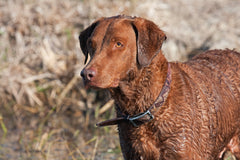4 Steps to Tune Up Your Bird Dog for Hunting Season
 Your gun is cleaned and oiled, your gear is laid out, and you’re ready to hit the backcountry for bird hunting season.
Your gun is cleaned and oiled, your gear is laid out, and you’re ready to hit the backcountry for bird hunting season.
But is your dog as ready to go as you are?
Just like humans, bird dogs can get out and shape and complacent in the off-season. They put on weight, forget their training and can backtrack on all of the hard work you both put in every fall. Sure, it’s important to exercise your dog year-round to keep it fit and agile, but there are several specific steps that all hunters should take to make sure that their loyal companions are ready for the season.
Here are four key steps to tune up your bird dog, according to PetMD, an online portal for veterinary health information.
Start early
Ideally, the process of getting your bird dog back into hunting shape should begin at least six to eight weeks before the season starts. As any short-term gym member can tell it, it takes time to build up your fitness level, and the same holds true for your dog.
Also, just like us, dogs can get injured when overworked or ramped up too quickly in terms of exercise. Start slow and work up the intensity heading into the fall.
If your dog is overweight, adjust their caloric intake as you increase their activity level to help it burn it off and tone up naturally.
Visit the vet
It’s smart to schedule your dog’s annual physical with the vet for the late summer or early fall, so that you can make sure they’re in top condition heading into hunting season.
While you’re there, ask about any vaccinations your dog might need and verify that they are up to date on all flea, tick and heartworm preventative medications.
Refresh their field skills
Basic obedience training should be a daily part of your dog’s life year-round, but it’s worth setting aside some time to work with them on the basics—sit, stay, heel, steady, etc—before taking them out into the field for the first time each year.
The same applies to all of the other skills that good hunting dogs possess. Go through your marking and retrieval exercises again to make sure your dog remembers exactly what they need to do out there and how you need them to respond to action.
Update your dog’s safety gear
If you’re using a GPS tracking system or e-collar in the field, be sure to check that it is not only functioning properly but that it still fits your dog comfortably. If the connections are frayed or the webbing is loose it might be time for replacement.
The same goes for any vest, reflective collar or other gear your dog might wear. Check for wear and replace anything that might not stand up to the rigors of the season.
